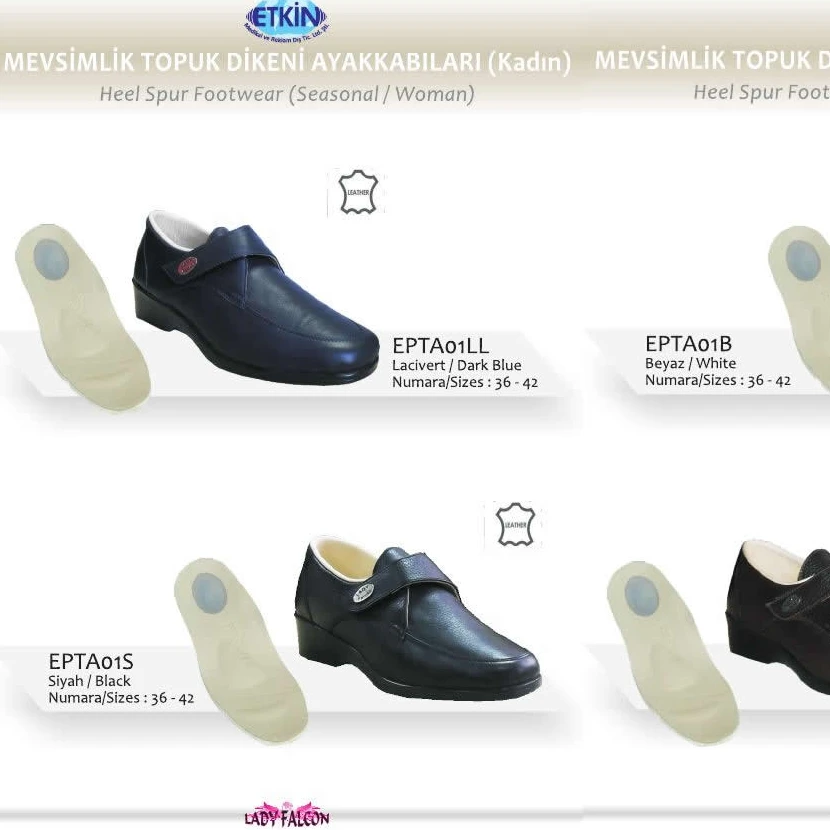Женская обувь для пяток сезонная (Epin Calcaneus) лучшего качества
- Категория: Прочая обувь специального назначения >>>
- Поставщик: ETKIN,MEDIKAL,VE,REKLAM,DIS,TICARET,LIMITED,SIRKETI
Поделиться:
Описание и отзывы
Трекер стоимости
| Месяц | Минимальная цена | Макс. стоимость |
|---|---|---|
| Sep-19-2025 | 0.28 $* | 0.30 $* |
| Aug-19-2025 | 0.8 $* | 0.79 $* |
| Jul-19-2025 | 0.66 $* | 0.68 $* |
| Jun-19-2025 | 0.89 $* | 0.21 $* |
| May-19-2025 | 0.25 $* | 0.83 $* |
| Apr-19-2025 | 0.6 $* | 0.64 $* |
| Mar-19-2025 | 0.50 $* | 0.47 $* |
| Feb-19-2025 | 0.5 $* | 0.51 $* |
| Jan-19-2025 | 0.88 $* | 0.74 $* |
Характеристики
Product Features
* Made from extra soft napa leather
* the product is lightweight and comfortable.
* 35 density foam is produced for supporting soft shoes.
* Spiked heels are manufactured specially for patients who suffered discomfort.
* Genuine leather carved heel of special orthopedic insole was used.
* Genuine leather interior and the exterior was used in the custom manufacturing.
* Shoe has antibacterial properties and does not sweat.
* The shoes has a special silicon at the back.
* Color Options
Summer models : Black,brown and beige
Seasonal model: Black and brown
* Production numbers are 36-37-38-39-40-41-42
* Brand: Ladyfalcon
Other Heel Spurs Seasonal Woman Shoes Models







Certifications


What Are Heel Spurs
A heel spur is also called a calcaneal spur because it occurs on the calcaneus, which is the Latin term for the heel bone. The most simple explanation for a bone spur is that it is an extra growth of bone on top of existing, normally formed bone tissue. Heel spurs tend to be small pointed growths of bone. Their presence is usually associated with soft tissue structures that attach to bones. Two of the most common soft tissue structures that can be related to the development of heel spurs are the tendons and the fascia of the foot.
There are various types of heel spurs. A posterior heel spur is one that develops on the back of the heel, right at the point where the Achilles tendon is connected to the heel bone. An inferior heel spur develops on the bottom of the heel bone and often a complication of another condition known as plantar fasciitis. This means that heel spurs in this location, also described as beneath the sole of the foot, can be related to inflammation of the plantar fasciia, which is the large tendon covering the bottom of the foot. It can also be related to the arthritic condition of akylosing spondylitis.
Posterior heel spurs are frequently large and bulbous enough to be felt through the skin. Because they are located at the point where the Achilles tendon joins the bone, they can be related to the condition of Achilles tendonitis. This condition basically refers to irritation and inflammation of the Achilles tendon, which is the tendon that gives each foot most of its strength. Heel spurs at the back of the heel can cause pain, tenderness, and discomfort whenever the patient pushes off using the ball of his foot, since this action stretches the Achilles tendon. Therefore, when Achilles tendonitis is treated, heel spurs may have to be removed in order to make the treatment as effective as possible.








